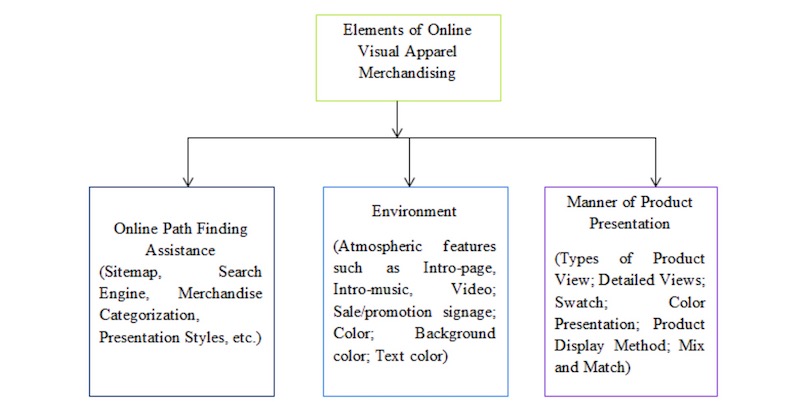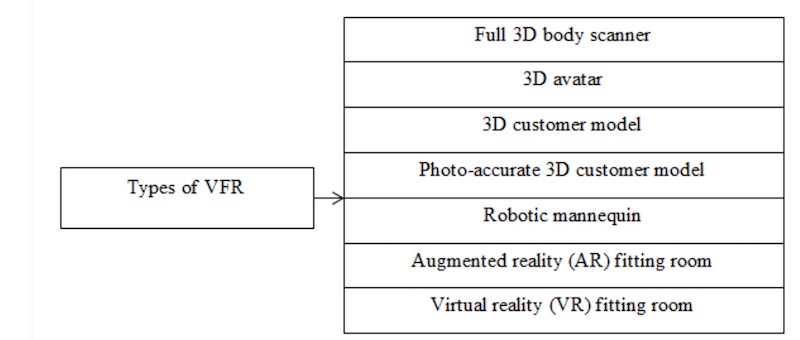Author: Md. Khalilur Rahman Khan – Former Assistant Professor
Bangladesh University of Business and Technology / Email: [email protected]
Abstract: With the increased popularity of window and floor displays, visual merchandising has been established. Similarly, in recent times, the popularity of online garment buying has surged, mandating the development of online visual merchandising for the apparel and fashion sectors.
It is the strategic presentation of a firm and its products through electronic retailing with the goal of attracting customers and making purchases easier. In fact, it’s a cutting-edge approach with a plethora of potential benefits and drawbacks. In the apparel sector, intangibility is the leading risk factor in online purchases.
As a result, technologies (like as virtual try-ons) have been devised to provide the non-touch shopping experience more confidence; nonetheless, they are still no alternative for the in-person experience. This article presents a review of online visual merchandising for apparel & fashion industry, aiming to address the core elements, perceived risk and various tools of online visual merchandising for apparel and fashion industries.
Introduction
The process of presenting and exhibiting items in any trading context is known as visual merchandising. The discipline focuses on capturing the attention and engagement of the client, providing a physical manner to enhance the goods, increasing brand awareness, and, ultimately, inducing a purchase [1].
The tactical roles of visual merchandising are to communicate the brand and its product to similar target customers in all marketplaces. It distinguishes the merchandise and the retail brand apart from competitors who sell similar things [2]. However, as a result of technological developments and ongoing improvements on the internet, customers’ shopping habits are changing [3].
Furthermore, the recent pandemic crisis has resulted in the highest growth in internet shopping to date, as physical separation is advocated globally [4]. As a result, the Internet has grown in importance as a source of information for consumers and a platform for businesses to reach out to customers. Retailers must improve their strategy to entice clients as the number of shoppers purchasing things from online businesses climbs.
As a consequence, merchandising approaches are exploring fresh soil on which to grow. This technical advancement has resulted in the emergence of a new scientific discipline known as online visual merchandising. It is the practice of incorporating visual components into internet websites in order to improve the overall experience. Indeed, advances in digital technologies and innovative user interfaces are helping to translate the in-store experience to the online space [5-7].
Apparel is normally acknowledged of as an experiential item that must be physically examined by feeling and trying on in order to be valued. Because clients, who are sensory beings, are unable to touch the garments when buying online, delivering a visual experience similar to that offered in a physical store becomes critical. As a result, individuals who experienced sensory pleasure from the product and/or display were more likely to buy clothes online.
Online websites and even mobile applications must be visually attractive to stand out and utilize digital methods to achieve their merchandise intriguing and engaging customers with newly developed interactions, just the same as in-store environment, lighting, setting, and showcase are crucial for any apparel brand to interest customers. A product detail that is believed to influence a consumer’s purchase decision can be presented visually [5-6].
Many clothes retailers have recently switched from traditional retail to e-commerce to market their products. Luxury firms like as Burberry are developing future retail concepts to attract customers by leveraging online and digital visual merchandising to create a web store that mirrors their physical store with similar set-ups, atmosphere, and atmospherics.
Live streaming of in-store shows and performances is also available. However, in this article, it is attempted to review the elements of online visual merchandising along with describing the various tools utilized for online visual merchandising of apparel and fashion industry, aiming to increase the knowledge for performing further research studies.
Core Elements of Online Visual Merchandising
In fact, online apparel retailers must improve OVM strategies, including page layout and product presentation, as well as the incorporation of more viewing experiences (e.g. partial views, whole views, image enlargement), supplementary functional alternatives (e.g. views of various body shapes/sizes, different garment colors), and aesthetic presentation offerings (e.g. alternative backgrounds, alternative model/mannequin poses) [3].
Certain essential elements (shown in figure-1) must work together to produce a memorable shopping experience for online visual merchandising to be profitable, involving product photos, material from delighted customers, color and overall aesthetics, mobile layout, ranking tactics, and personalization.

Ha et al. investigated online visual merchandising (VMD) on apparel websites and concluded that most of the VMD features and characteristics seen in offline retail stores have been replicated by online retailers, with some modifications to match the online environment. For example, online features such as sitemap, search engine, and various goods category presentation methods appeared to be equivalent to traditional in-store pathfinding assistance features.
Intro pages, intro music, and videos were employed as atmospheric features in the same way as image props, music, and videos are utilized in traditional retail stores to enhance the ambiance. Different forms of sale and promotion advertisements displayed on clothing websites served the same purpose as point of purchase and other display devices used in traditional apparel stores to inform customers of sales and promotions [8].
Online Visual Merchandising and Perceived Risk
Perceived risk is defined as the nature and degree of uncertainty perceived by consumers in contemplating a specific buying decision. Uncertainty and consequences may both play important roles in risk perception. Uncertainty, which is more subjective, is caused by differences between determining purchasing criteria and meeting these goals with product or brand offerings.
The perception that the product supplied after purchase will not satisfy the customer’s expectations is known as product uncertainty. The consequence, on the other hand, is linked to purchasing outcomes such as the product’s function, performance, psychological, social, and economic functions (e.g., Will the product perform as well as I expect?).
The inability to inspect or test the merchandise, as well as the limited product information provided, may raise the risk of a negative outcome when it comes to online visual merchandising in general, and clothes in particular [9]. As a result of the inaccuracy and uncertainty of garment color, fabric, and details, E-shoppers may avoid buying garments.
Because online apparel shopping is risky in and of itself, improved visual product presentation is required to lessen perceived risk. Online visual merchandising (OVM) may be more important for garments and accessories than for other online items in reducing these risks [5]. The inability to visually scrutinize fashion items is the most significant impediment to online clothes shopping [4].
Touching, feeling, and appropriate fitting are all crucial aspects to consider when buying garments; however, material or size examination cannot be done before purchasing. The color of the garment may differ slightly from that shown on the computer screen [9].
Improved visual displays that can compensate for physical sensory experience are one method to lower perceived risk. A three-dimensional presentation can also be employed to give a better sensory experience for buyers, making e-commerce more comparable with traditional retail [9]. Online buyers, on the other hand, may rely mainly on information provided through images on the computer to get enough information about garment quality and fit. To reduce risk perceptions and enhance buy intention, online apparel retailers should present a greater quantity and quality of product and customer service information on their websites [5,9].
Tools of Online Visual Merchandising
Both producers and buyers are concerned about the proper fit of clothes [10]. Fit-related issues account for over 70% of online returns in the fashion sector [11]. In fact, the difficulty with online visual merchandising stems from its failure to provide buyers with a practical opportunity to try before they buy, which is critical in the clothes and fashion industries. As a result, internet retailers’ costs have gone up, and consumers have expressed unhappiness. New technologies are being recognized by the industry as a solution to this challenge [12].
1. Virtual Dressing Room Technology
Virtual fitting rooms (VFR) (also known as virtual dressing rooms and virtual changing rooms) give the fashion industry new opportunities by allowing customers to virtually try on products [11]. A virtual try-on system is an integrated system that allows virtual clothing to be tried on, reducing time spent in retail and unnecessary visits to the mall. Customers can try on garments without donning them from the comfort of their own home or anywhere else using a computer or smartphone [13]. Figure 2 shows a concept sketch of a virtual dressing room.
![Figure-2. A concept sketch of a virtual dressing room [12].](https://kohantextilejournal.com/wp-content/uploads/2021/11/Screen-Shot-2021-11-19-at-14.32.56.jpg)
There are two primary types of VFR: clothing imitation on a two-dimensional likeness/photograph of a client (the so-called 2D overlay) and clothing imitation on a three-dimensional shape with the size of a consumer (the so-called 3D mannequin) [14]. Customers can try on any image of a garment for free in 2D virtual dressing, but they will not feel 3D fitting due to digital photographs of customers and garments. Because both the consumers and the garments are 3D models, 3D virtual dressing allows for 3D fitting. Customers can freely try on any clothing model in 3D areas, as well as choose their desired size, color, and texture [15]. Figure 3 depicts the various strategies utilized in virtual dressing rooms.

Customers do not need to buy special equipment, download software, measure themselves, or undergo 3D body scans because augmented reality (Webcam) VDRs use actual video’ reflections’ of shoppers, have little or no overhead for retailers, are convenient, interactive, and participating for clients, and do not necessitate consumers to buy specialist devices, download software, measure themselves, or undergo 3D body scans.
Rather, shoppers merely use a camera to superimpose virtual clothes or accessory items onto their bodies (in-store, at a kiosk, on their personal computer, or even from their smartphone). Though less fit-oriented than VR VDR services, Webcam VDRs propose to offer seamless, digital-era shopping experiences by allowing customers to interact with shopper-friendly software from anywhere at any time [3].
Augmented reality is an interactive real-world experience in which things in the real world are accompanied by computer-generated perception information, increasing their sense of reality [16].
The merits of using a virtual dressing room from home/office are numerous: decreasing the percentages of product returns; competitive advantages since the customer can try the clothes by utilizing the application from the web shop before purchasing and then reduce risk in the buying process; increased possibilities for customization – the customer are able to generate their own customized clothes; customers can easily record and upload a video wanting to show them with different clothes on social medias to get their friends opinions; the possibility to make different visualizations/augmented reality, e.g., the background can be changed, letting to see the clothes in the actual scenarios [12].
By immersing customers in VFRs, VFRs can be an excellent experiential strategy for offering enjoyable and hedonic purchasing experiences. In fact, through addressing sensory and social demands, VFRs have the ability to provide affective experiences [11]. Consumers may look through a larger selection of fashion collections and try on products through online channels.
VFR provides a big opportunity for the fashion sector by allowing people to virtually try on things [16]. However, because of the different levels of technology improvements in implementing virtual fitting and related interactive services, the accuracy, attractiveness, and interactivity might vary substantially [11].
2. Artificial Intelligence
Artificial Intelligence (AI) has risen to prominence as a key area of technical advancement. It has fundamentally altered the roles of merchandisers, particularly in the fashion business. AI has aided designers in combining trending colors, essential patterns, and styles by evaluating and storing insights from thousands of photos and videos using computer vision, which can cut overall lead times and extend designers’ creative discovery.
Fashion retailers have also employed AI in chatbots, virtual assistants, and product navigators to improve and combine customers’ online and offline shopping experiences [17].
It’s quickly becoming a valuable tool in online visual merchandising. Product collections are an important part of online apparel retailing in fashion retail. Shoppers can locate things they might not have noticed otherwise by creating collections by grouping products together based on trends, themes, or occasions.
One of the main goals of online visual merchandising is to draw in potential customers and engage with them in order to boost sales. Collections are a fantastic method to accomplish this. Furthermore, maintaining track of one’s fashion sense takes a lot of time and work, which is why some people consult a professional stylist. A computer program based on Artificial Intelligence could be the new fashion consultant, depending on how it is implemented. However, AI approaches are still not widely used in the industry [18-19].
3. Haptic technology
One of the important qualities in traditional shopping that gives the buyer confidence in purchase is the ability to touch and feel (tactile sensation) the garment. Fashion, on the other hand, is a hands-off experience in the internet realm, with customers unable to actively sense, perceive, and apprehend tactile garment qualities online as they would in an offline situation [20].
Much technological progress has been made to mirror the real-life tactile feeling in online buying, with images and words utilized in online websites through appearance representative evaluation words and tactile sensation representative evaluation words being one example. These enable customers to see and read feelings connected with touch and feel sensations, compare them to previous experiences, and make decisions as a result.
The textual haptic (active touch) information also improves the perception of the garment and promotes online shopping intent, making the goods seem more real. Furthermore, a method of image presentation using light transmittance is employed to realize tactile feeling in online platforms by analyzing the texture and physical property of the actual fabric, thereby displaying the thinness and thickness of a fabric.
Product rotation and touch-related characteristics like fabric scrunch can offer an immersive shopping experience that eliminates the need for physical touch when exploring fashion clothing online. [21]. Haptics-based systems use kinesthetics and/or tactile modalities to facilitate human-computer interaction. Haptic technology, when combined with virtual and augmented reality, could bring in a new, completely immersive, and presumably more inclusive digital fashion experience [22].
Conclusion
Visual merchandising for fashion and clothing industries is no longer limited to the confines of a physical boutique. As clothing sale is very visual, visual merchandising is particularly important when selling apparel online. Extensive, purposeful, and strategic digital design is essential for successful online visual merchandising since it provides customers with a memorable and repeatable buying experience. Online apparel retailers are continually refining time-tested techniques with the support of cutting-edge technologies that make the client experience even more engaging and valuable.
References
1. Fernando Aguileta De La Garza, The Importance Of An Omnichannel Visual Merchandising And Styling Strategy, 7 MAY 2021, Https://Elle.Education/Business/The-Importance-Of-An-Omnichannel-Visual-Merchandising-And-Styling-Strategy/
2. Hyun Hee Park, Jung Ok Jeon & Pauline Sullivan (2015) How does visual merchandising in fashion retail stores affect consumers’ brand attitude and purchase intention?, The International Review of Retail, Distribution and Consumer Research, 25:1, 87-104, DOI: 10.1080/09593969.2014.918048
3. Yaoyuneyong, Gallayanee & Foster, Jamye & Flynn, Leisa. (2014). Factors impacting the efficacy of augmented reality virtual dressing room technology as a tool for online visual merchandising. Journal of Global Fashion Marketing. 5. 283-296. 10.1080/20932685.2014.926129.
4. Jang, S.Y., Ha, J. The influence of tactile information on the human evaluation of tactile properties. Fash Text 8, 39 (2021). https://doi.org/10.1186/s40691-020-00242-5
5. Ji, Xiaofen & Pang, Chen. (2006). Online Visual Merchandising of Apparel E-retailers. 307 – 311. 10.1109/IEMC.2006.4279873.
6. Online visual merchandising – the future of retail, Aug 2014, https://www.fibre2fashion.com/industry-article/7405/online-visual-merchandising-the-future-of-retail
7. Perry, Patsy & Blazquez, Marta & Padilla, Stefano. (2013). Translating the need for touch to online fashion shopping via digital technology.
8. Ha, Y., Kwon, W., & Lennon, S.J. (2007). Online visual merchandising (VMD) of apparel web sites. Journal of Fashion Marketing and Management, 11, 477-493.
9. Khakimdjanova, Lola & Park, Jihye. (2005). Online visual merchandising practice of apparel e-merchants. Journal of Retailing and Consumer Services. 12. 307-318. 10.1016/j.jretconser.2004.10.005.
10. 3D body scanners: Virtual trials for real comfort, Sep 2013, https://www.fibre2fashion.com/industry-article/7060/3d-body-scanners-virtual-trials-for-real-comfort
11. Hanna Lee & Yingjiao Xu (2019): Classification of virtual fitting room technologies in the fashion industry: from the perspective of consumer experience, International Journal of Fashion Design, Technology and Education, DOI: 10.1080/17543266.2019.1657505
12. Holte, M. B. (2013). The Virtual Dressing Room: A Perspective on Recent Developments. Lecture Notes in Computer Science, 241–250. doi:10.1007/978-3-642-39420-1_26
13. Li, C., & Cohen, F. (2020). In-home application (App) for 3D virtual garment fitting dressing room. Multimedia Tools and Applications, 80(4), 5203–5224. doi:10.1007/s11042-020-09989-x
14. Moroz, Miroslaw. (2019). Tendency to Use the Virtual Fitting Room in Generation Y – Results of Qualitative Study. Foundations of Management. 11. 239-254. 10.2478/fman-2019-0020.
15. https://www.irjet.net/archives/V7/i3/IRJET-V7I31015.pdf
16. Werdayani, D & Widiaty, I. (2021). Virtual fitting room technology in fashion design. IOP Conference Series: Materials Science and Engineering. 1098. 022110. 10.1088/1757-899X/1098/2/022110.
17. Liang, Y., Lee, S.-H., & Workman, J. E. (2020). Implementation of Artificial Intelligence in Fashion: Are Consumers Ready? Clothing and Textiles Research Journal, 38(1), 3–18. https://doi.org/10.1177/0887302X19873437
18. Wang, Haosha & Rasheed, Khaled. (2014). Artificial Intelligence in Clothing Fashion.
19. Giri, Chandadevi & Jain, Sheenam & Zeng, Xianyi & Bruniaux, Pascal. (2019). A Detailed Review of Artificial Intelligence Applied in the Fashion and Apparel Industry. IEEE Access. PP. 1-1. 10.1109/ACCESS.2019.2928979.
20. Ornati M., Cantoni L. (2020) FashionTouch in E-commerce: An Exploratory Study of Surface Haptic Interaction Experiences. In: Nah FH., Siau K. (eds) HCI in Business, Government and Organizations. HCII 2020. Lecture Notes in Computer Science, vol 12204. Springer, Cham. https://doi.org/10.1007/978-3-030-50341-3_37
21. Gopura, S., & Kothalawala, L. (2021). Confused Customer: Sizing and Styling Related Matters in Online Fashion Shopping in Sri Lanka. Open Journal of Social Sciences, 9, 110-127. https://doi.org/10.4236/jss.2021.99008
22. Ornati, Michela (2020) Surface Haptics and the Fashion Digital Experience (conference workshop). In: IMPEC 2020 Conference “Sensorialités”, 1-3 July 2020, Lyon (online).




















